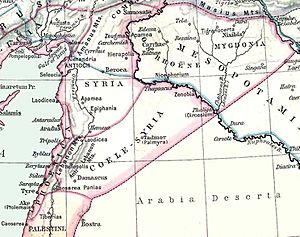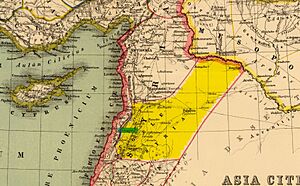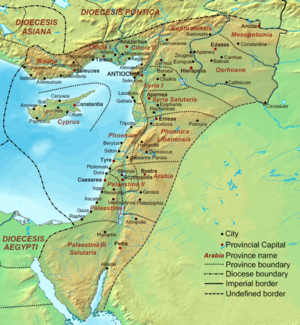Coele-Syria facts for kids
Quick facts for kids Coele-Syria |
|||||||||||||||||
|---|---|---|---|---|---|---|---|---|---|---|---|---|---|---|---|---|---|
| Region of Macedonian Empire / Ptolemaic Kingdom / Seleucid Empire/ Kingdom of Armenia (antiquity) | |||||||||||||||||
| 332 BCE–64 BCE | |||||||||||||||||
 |
|||||||||||||||||
| Historical era | Hellenistic era | ||||||||||||||||
|
• Conquests of Alexander the Great
|
332 BCE | ||||||||||||||||
| 274–168 BCE | |||||||||||||||||
| 140 BCE | |||||||||||||||||
| 64 BCE | |||||||||||||||||
|
|||||||||||||||||
Coele-Syria (pronounced SEE-lee-SIR-ee-uh) was an important area in ancient Syria. The name comes from a Greek phrase meaning "Hollow Syria." It first referred to the "hollow" Beqaa Valley located between the Lebanon and Anti-Lebanon mountain ranges.
However, sometimes the name Coele-Syria was used for a much larger part of the Syrian region. Today, this area is part of modern-day Syria and Lebanon.
Contents
What's in a Name?
The word "Coele" in Coele-Syria means "hollow" in ancient Greek. People think this name came from the Beqaa Valley, which is a long, hollow valley between two mountain ranges.
But some experts believe the name "Coele" might actually come from an older Aramaic word, kul, which means "all" or "entire." If this is true, then Coele-Syria would have originally meant "all of Syria."
Ancient writers used the term in different ways. Some, like Pliny and Ptolemy, used it to mean "all Syria" or "all Syria except Phoenicia." Others, like Strabo, used it more narrowly to describe the area south of the Eleutherus river, which was once controlled by the Ptolemies.
The name "Coele-Syria" was officially used during the time when the Seleucid Empire ruled the region, from about 200 BCE to 64 BCE.
Official Use of the Name
During the Seleucid Empire's rule, the title "Strategos and Archiereus of Coele-Syria and Phoenicia" was given to important officials. A strategos was a military general, and an archiereus was a chief priest.
One famous example was Ptolemy Thrasea, a former officer who switched sides to join the Seleucid king Antiochus III the Great. Antiochus gave him this important title.
The Syrian Wars
Coele-Syria was a very important region, and two powerful empires, the Seleucid dynasty and the Ptolemaic dynasty (who ruled Egypt), fought over it for many years. These conflicts are known as the Syrian Wars.
After Alexander the Great died, his generals divided his huge empire. One general, Ptolemy I Soter, took control of Coele-Syria in 318 BCE. However, he often had to pull his troops out due to other battles.
In 301 BCE, after a major battle called the Battle of Ipsus, Coele-Syria was supposed to go to Seleucus I Nicator. But Ptolemy had already taken control of it. Seleucus allowed Ptolemy to keep it for a while, perhaps because Ptolemy had helped him in the past.
However, later Seleucid rulers were not so understanding. This led to a century of wars between the Ptolemies and Seleucids over Coele-Syria. The Battle of Panium in 200 BCE was a major turning point. In this battle, the Seleucids finally defeated the Ptolemies and took full control of the region.
Seleucid control over areas like Judea began to weaken around 165 BCE due to the Maccabean Revolt. By 140 BCE, Judea had gained its independence. Finally, in 64 BCE, the Roman general Pompey conquered the region, and Syria became part of the powerful Roman Republic.
Different Names for Syria
Ancient historians often used the name "Syria" to describe a very large area. This area stretched from the Tigris River in the east all the way to the Mediterranean Sea in the west.
The part of Syria east of the Euphrates River was sometimes called "Syria between the rivers." The part to the west was often called Coele-Syria. Sometimes, even Phoenicia and Palestine were included in this larger "Coele-Syria" region, stretching all the way to Egypt.
| Names for Syria around 530 BCE | ||
|---|---|---|
| Main Name | Kul Eber-Nari | Meaning: All Across-the-River |
| Another Name | Koile Syria | Meaning: A Greek translation |
After Alexander the Great died, his generals fought over his empire in what were called the Wars of the Diadochi. Coele-Syria first came under the control of Antigonus I Monophthalmus. Then, Ptolemy I Soter took control of the region. Even though Coele-Syria was officially given to Seleucus I Nicator, Ptolemy kept it. This disagreement led to many future wars between their descendants.
The ancient writer Polybius described the wars over Coele-Syria. He wrote about how Ptolemy's army marched through the desert to reach Rafah, which was the first city of Coele-Syria on the Egyptian side.
Later, other ancient texts also mentioned Coele-Syria. For example, the books of Maccabees mention a general named Apollonius who was governor of "Celesyria." The historian Diodorus Siculus described Egypt's border reaching as far as Jaffa in Coele-Syria.
Coele-Syria Proper
During the Roman period, writers had different ideas about where Coele-Syria began and ended. The writer Strabo described "Coele-Syria Proper" as the area specifically located between the Libanus and Anti-libanus mountain ranges. These ranges run parallel to each other.
However, in the wars between the Ptolemies and Seleucids, the name Coele-Syria was used for the entire southern part of Syria. Under the Romans, the term "Coele-Syria Proper" was used more strictly. It sometimes included the area around Damascus (east of the Anti-Libanus mountains) and parts of Palestine east of the Jordan River.
| Names for Syria by Strabo around 10 BCE | ||
|---|---|---|
| Main Name | Cœlê-Syria & Seleucis-Syria & Phœnicia &c. &c. | Cœlê-Syria was different from Cœlo-Syrians |
| Another Name | Cœlo-Syrians & Syrians & Phœnicians | Similar to names used by Herodotus |
Other ancient writers also mentioned Coele-Syria. Philo of Alexandria wrote that Moses led his people into Phoenicia, "hollow Syria" (Coele-Syria), and Palestine. Pomponius Mela described Syria as a large region with different names, including Coele, Mesopotamia, and Judaea.
The name "Syria" itself comes from an ancient Greek name for the Levant region. This area was once part of Assyria.
Pliny the Elder described Syria as a very large land with many divisions. He mentioned that the part next to Arabia was known as Palestine, Judaea, or Coele. He also noted that the Ituraei people of Coele-Syria were famous for their archery skills.
The Roman emperor Hadrian later made the city of Damascus the "Metropolis of Coele-Syria," meaning it was the main city of the region.
Appian, another Roman historian, described Coele-Syria as stretching from the sea inland to the Euphrates River, including places like Palmyra.
The Decapolis was a group of ten cities. Pliny the Elder listed these cities. Interestingly, what Pliny called the Decapolis, Ptolemy called his "Coele-Syria." This shows how the name was used differently by various writers.
Provincia Syria Coele
Over time, the Roman Empire changed how it governed Syria. At first, one governor managed the entire large province. But in the second century CE, the province was divided.
Later, around 200 CE, Emperor Septimius Severus divided the large province of Syria into smaller parts. One of these new provinces was called Provincia Syria Coele. This new province was in the northern part of the old Syria. Other new provinces included Syria Phoenice and Syria Palaestina.
| Names for Syria around 200 CE (Roman period) | ||
|---|---|---|
| Syria | Provincia Syria Coele | This was a Roman province, different from the older Coele-Syria |
| Phoenice | Provincia Syria Phoenice | |
| Palestina | Provincia Syria Palæstina | |
| Arabia | Provincia Arabia Petraea | |
The city of Antioch became the capital of the Roman province of Syria Coele. This city was very important and was founded by Seleucus Nicator.
See also
- Hasmonean kingdom
- Roman Syria
- Herodian kingdom
- Tetrarchy (Judea)
- Judaea (Roman province)
- Syria Palaestina









